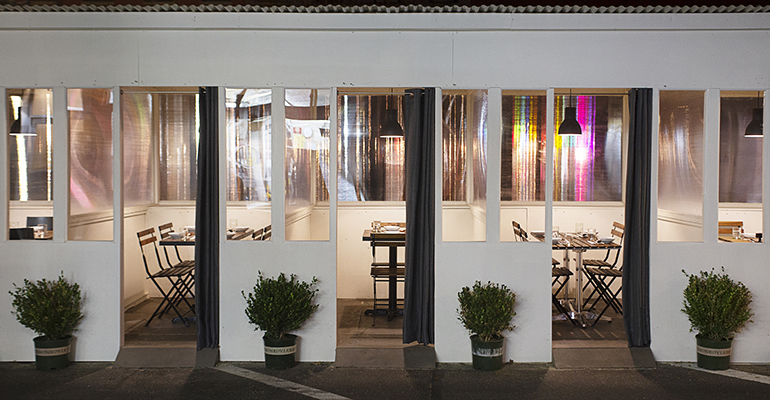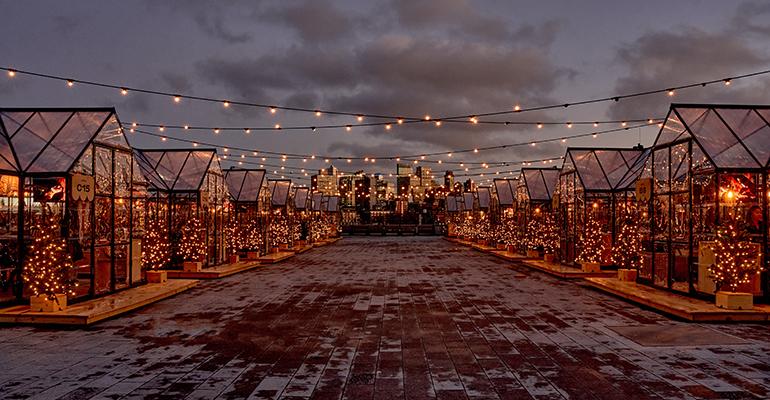As temperatures drop and COVID-19 rates keep rising, operators are coming up with creative ideas to avoid facing a complete shutdown, from filling parking lots with yurts or tents to buying fully enclosed private igloos and bubbles.
But just how safe are these winter dining solutions? The answer is complex and depends on how much air flow the seating area is getting, how often the outdoor dining space is sanitized and how far parties are spaced out.
Make it breezy
“These structures are basically like recreating the indoors outdoors and you lose the benefits of eating outdoors,” said Dr. Linsey Marr, an engineer and expert in the airborne transmission of diseases at Virginia Tech. “When you’re in the open air the large droplets and aerosol we produce when we talk are rapidly depleted. A tent defeats the purpose and would only be a little bit better ventilation-wise than eating inside the restaurant.”
Marr suggests that restaurants erect outdoor dining structures with no more than two sides to allow for proper airflow. Once you get to three walls, she said, the people furthest from the open area will lose the benefit of eating safely outdoors. She also has a simple trick for figuring out whether or not an outdoor dining space is safe:
“If it’s windy, you should be able to feel a breeze,” Marr said. “You should not be able to smell any food from the table next to yours because those odors should be wafted away outside.”
Of course, dining outside without much shelter defeats the purpose of finding a comfortable solution to following COVID-19 restrictions and guidelines during the winter months.
Go beyond social distancing guidelines
Although six feet apart has been the social distancing mantra throughout the pandemic, both experts we spoke with suggested that this might not be enough.
“There’s a lot about the risks that we don’t understand yet because COVID has been with us for less than a year,” said Dr. Tiffany Harris, an epidemiologist and public health expert at Columbia School of Public Health. “The further apart you can keep the tables, the better. I would say at least nine feet or more.”
Washington, D.C.-based boutique architecture firm 3877 has been working with multiple restaurants to come up with outdoor dining design solutions that prioritize social distancing. While “everyone has come up with the idea of using tents, and propane heaters are on backorder everywhere,” 3877 partner David Shove-Brown said that they’ve tried to think outside the box for clients like TacoVision taqueria in New York.
“A lot of our social distancing strategy is about creating those nooks for individual parties,” Shove-Brown said. “You can’t just have one big platform with spaced-out tables. We are using things like wood pallets and planters to divvy up the space and separate parties. So, seating groups of six people together feels more like you’re inside.”
Approach private dining rooms with caution
The trend of installing a “tent city” of self-contained igloos and bubbles to keep out both the cold and the germs goes hand in hand with social distancing guidelines. After all, if these private dining rooms are only meant to house parties of six or fewer, then the walls or the sides of an igloo will keep their aerosol droplets separate from other tables.
“I do think these pods can be problematic because often people are dining with non-household members and if they happen to be sick and then you’re sitting in an enclosed space with them, then that’s problematic,” Harris said. “There are so many questions, like how often do we clean them? How long do these pods air out between parties? Are you sanitizing every single surface in the pod?”
Some state guidelines are addressing these concerns. The Connecticut state legislature initially banned the use of dining pods or igloos in early November, but went back on their ban on Nov. 6, allowing the outdoor dining structures if they have “two or more window-style vents open at all times” and have “adequate ventilation” at all times.
The Greens on The Rooftop at Pier 17 in New York City’s Seaport District is an open-air venue with a rooftop lawn and bar. During the warmer months, it was the ideal outdoor venture for socially distanced socializing.
But as winter approached, The Greens erected 28 12-foot-by-10-foot cabins for private parties to allow for safe social distancing. For $50, parties can rent out the cabins for up to eight people.
Each cabin has a dining room table, a digital fireplace visual and an air purifier. Cabins are empty between reservations for 20 minutes to assure the spaces are aired out, during which time employees use electrostatic sprayers to sanitize the entire cabin and all surfaces.

Oiji erected seven heated and ventilated private rooms for up to six people in each in their parking spaces on the street for the colder months.
“We created custom designed layouts of the cabins for seamless social distancing,” said Pawel Brzezinski, executive vice president of operations and strategy for Creative Culinary Management. “Guest safety is our top priority. For example, as another precaution, our dishes are served in eco-friendly disposable containers. No one ever touches the same fork, knife, or plate.”
Oiji, a Korean restaurant in New York City, has a similar setup. In addition to the 25% capacity currently allowed for their dining room, they erected seven heated and ventilated private rooms for up to six people in each in their parking spaces on the street for the colder months.
Instead of a door, each room has a curtain at the entrance to allow for better airflow, and each room is heated by 3,000-watt mighty dual heaters.
Oiji owner Brian Kim said they are also installing ventilation in each room, “like fans that you would have in a public bathroom” to allow for even more air flow.
In between seatings, he said, they make sure to sanitize all surfaces in each room and air out the rooms for 15 minutes between parties.
“I believe this is the safest way for customers to dine: to be completely separate from each other,” Kim said.
Have a plan for employee safety
Of course, customer safety is not the only concern for restaurants. Brzezinski said that when they designed their private cabins, they wanted to limit employee interactions with customers as much as possible, so they installed a Kallpad touchless ordering system inside each cabin. Guests can place their orders via QR technology and then employees are alerted so they know exactly where the order is coming from.
If customers need help, they can, “at the press of a button,” let staff know, and employees will be notified via their smart watches, thereby cutting down on employee-customer interaction.
“We implemented Kallpad technology to make sure we’re not invading guest privacy and our service is drop-off style: you place your order through the QR codes and our runners open the door and drop off the plates,” Brzezinski said. “The guests are responsible for taking care of the rest and can press the button if they need us further.”
This technology follows recommendations from experts that recommend that restaurant staff distance from guests as much as possible, in addition to taking wellness and temperature checks before each shift.
“Waitstaff should minimize their time in these [outdoor structures],” Marr said. “Just hand things through the door and don’t go inside. Remember that eating indoors is one of highest risk activities we can do during the pandemic.”
Contact Joanna Fantozzi at [email protected]
Find her on Twitter: @JoannaFantozzi





